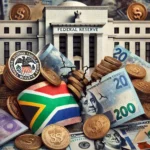The dollar held steady near recent highs on Tuesday ahead of an anticipated interest rate cut in the United States, as traders adjusted their expectations for higher long-term rates.
The euro, which is on track for a nearly 5% decline against the dollar this calendar year, remained close to recent lows, trading at $1.0509 during the Asian session. Markets appeared in a holding pattern ahead of the Federal Reserve’s upcoming decision.
The yield gap between U.S. and German 10-year bonds now stands at 216 basis points, having widened by nearly 70 basis points over the past three months.
Meanwhile, the yen held firm at 154.06 per dollar after six consecutive sessions of declines. Market expectations for a Japanese rate hike this week have diminished, with traders now favoring a move in January.
The Federal Reserve will announce its interest rate decision on Wednesday, with interest rate futures indicating a 94% probability of a cut, despite a surge in services-sector activity to a three-year high, as shown by an S&P Global purchasing managers survey.
The Atlanta Fed’s GDPNow model projects fourth-quarter growth at 3.3%, reflecting the economy’s resilience. This strength has lifted yields and supported the dollar, as traders increasingly believe the neutral interest rate level may be higher than previously anticipated.
In September, Fed officials’ median long-run interest rate projection was 2.9%. However, current market pricing suggests little likelihood of rates falling that low by December 2024 and only a 30% chance of the Fed Funds rate dropping below 3.75% by the end of 2025.”The Fed may now be concerned about a resurgence of inflation, as an uncertain policy mix and sticky prices create multiple pathways for inflation to return in 2025,” said Brent Donnelly, president of Spectra Markets.
“As a result, I expect the Fed to signal a very cautious approach moving forward and emphasize language that reflects concerns about inflation and a potentially higher neutral rate.”
Beyond the Fed, central banks including the Bank of Japan, Bank of England, and Norges Bank are set to meet this week, with all three expected to hold rates steady on Thursday. Meanwhile, the Riksbank is anticipated to cut rates, possibly by as much as 50 basis points.
Sterling rebounded on Monday after a business activity survey indicated rising prices in Britain. Upcoming labor data, due on Tuesday, could highlight upward pressure on wages, strengthening the case for a cautious stance from the Bank of England. Sterling was last trading at $1.2680.
The Canadian dollar slid to a 4-1/2 year low on Monday, weighed down by falling interest rates and concerns over potential U.S. tariffs. The sudden resignation of Finance Minister Chrystia Freeland added further pressure to an already unpopular government.
The Australian and New Zealand dollars remain near yearly lows but avoided additional selling following weak Chinese economic data on Monday, as markets are betting on increased government spending to support growth.
The Aussie fell 0.2% to $0.6356, while the kiwi slipped to $0.5769. New Zealand also raised its bond issuance forecast for the coming years.China’s yuan held steady at 7.2845 per dollar, as pessimistic expectations for Chinese economic growth kept 10-year bond yields near record lows.
According to sources familiar with the matter, Chinese leaders agreed last week to raise the budget deficit to a record 4% of GDP next year while maintaining an economic growth target of around 5%.





